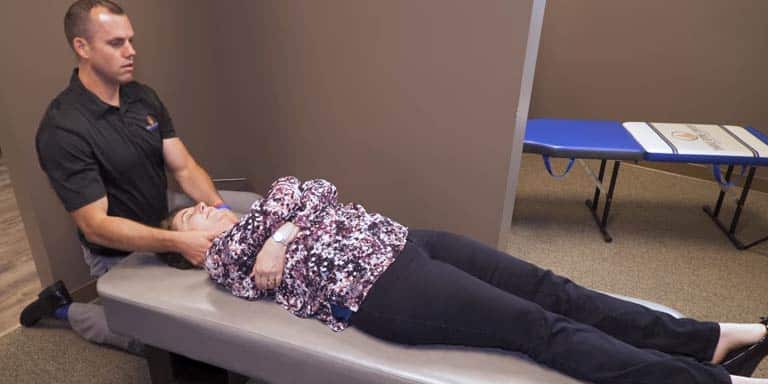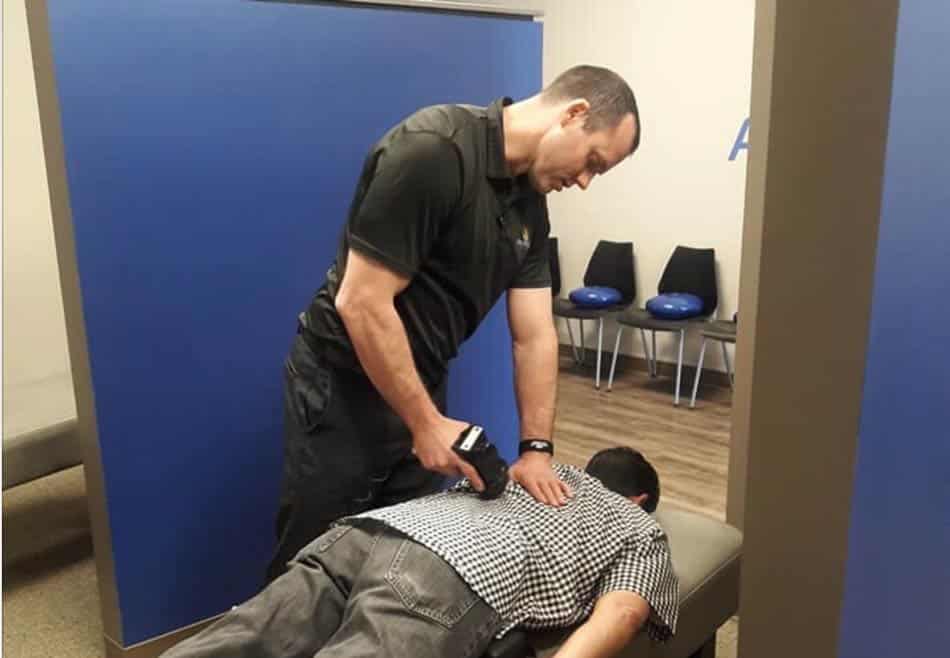One of the Most Common Causes of Migraines: Loss of Curve in the Neck (Video)
Migraine headaches are a debilitating type of headache that can cause intense pain, sensitivity to light and sound, and even loss of vision. For people living with migraine, understanding the triggers and effective treatment options is essential. In this article, we explore one of the most common yet often overlooked causes of migraines: the loss of curve in the neck.
Migraine headaches affect millions of people around the world, and they are more than just a type of headache. A migraine attack can be excruciating, leading to severe pain, neurologic symptoms, and a host of other debilitating effects. The trigger for a migraine attack can vary from person to person, and for many, it remains a mystery. However, one often overlooked trigger is the loss of curve in the neck.
Video Transcript:
How’s it goin’? Dr. Jay here with Thrive Spine Center in beautiful Folsom, California. I’m here with our full spine skeleton Dr. Bones today we are gonna talk about headaches and migraines. As a chiropractor I have been a chiropractor now for over years and we’ve had a lot of success with headaches and migraines in our office. I know all about chronic pain because I’ve felt Pain before I actually became a chiropractor and I know all about Headaches and migraines because I’ve seen it in my patients. but the good news is there is an answer out there and the answer doesn’t have to be a bottle of pills like Imitrex or Topamax that come with all those severe side effects. The answer could be just in merely correcting your spine and I’ll explain how. Typically in my clinical experience what I’ve seen is that migraine sufferers typically have a loss of curve in their neck. This is a patient who came in with 34 years of migraines she had a complete loss of curve in her neck we’re supposed to have a nice 34 to 45 degree curve in our neck and she had forward head posture. Her head was actually shifted forward by 35 millimeters. The problem with that is it creates all this tension and stress throughout the neck and it causes tightness in these muscles called the suboccipital muscles. Now you have nerves that come out of here that go right into the head so if those muscles tighten up they are going to put pressure on those nerves they’re going cause nerve irritation that can lead to headaches and migraines. So by correcting the spine adjusting the spine and getting the bones moving better and getting the pressure off the nerves and working on bringing a normal curve back in the neck And getting the head back on top of the shoulders those muscles relax and you end up with less nerve irritation you have better brain-body connection and essentially the body can heal itself from the inside out when removed of interference. This patient who came in was suffering with years of migraines. In fact when I met her in the midst of our conversation she started having a migraine. So I said look you need to come in we’re having a new patient special here’s my card. She ends up coming in we took x-rays on her neck and she was initially skeptical but guess what within two weeks of corrective chiropractic care years of migraines almost completely went away in terms of intensity and frequency. The amount of time she felt the migraines went down and the intensity of her migraine actually went down when she felt them. Within the course of care she didn’t notice that she was having migraines anymore. And let me just tell you that’s the power of chiropractic and that’s why I became a chiropractor because I wanted to help as many people as possible. I realized that there was a drug epidemic in this country. Country and it didn’t haveanything to do with street drugs. It has everything to do with we are over-prescribed we’re over-medicated and we have all of these health issues thereof. In the United States we take more drugs than any industrialized country on the face of the planet yet we’re one of the sickest countries.And we’re supposed to have one of the best healthcare systems. I just believe the answer is so much more than that. So guess what? If you’re suffering with chronic headaches and migraines like millionAmericans are suffering with headaches and migraines right now if you’re one of the 18% of womenthat suffers with chronic migraines or you’re one of the 6% of men that suffers with chronic migraines guess what? There is an answer out there for you and we’re offering a chance to come in toour office to see if chiropractic can be a good option for you. We have a new patient special going on right now. I call it the superhero new patient special. Right now because we’re actually in the midstof doing our blockbuster movie week in the office and we are raffling off tickets for the new Avengers movie that’s out right now in theaters. Anyway the new patient special consists of a thorough consultation a complete examination a complete set of digital x-rays and a report of findings. So that means after I take those x-rays on you I’m gonna sit down with you and we’re gonna go over those x-rays. I’ll go over what’s workin’ what’s not workin’ and I’ll lay out a plan of action for correcting what’s going on in there as opposed to just giving you temporary relief at best. If you’re tired of suffering with chronic pain tired of suffering with chronic headaches and migraines maybe this could be the answer for you. So give our office a call at 916-587-1276 or click the link below and get signed up today. If you sign up today we’ll also give you tickets for our dinner with the doc program that we teach here in the office where we pay for a healthy meal for you and we deliver a powerful health message thereof. Give us a call and I look forward to seeing you soon. Have a great day!
Understanding Migraines
Before we delve into the connection between neck curvature and migraines, it’s important to understand what a migraine is. Migraine is a common type of headache disorder characterized by recurrent and intense headaches that can last for hours or even days. The symptoms can include sensitivity to light and sound, nausea, and vomiting. Some individuals may also experience an “aura” before the headache begins, which can involve visual disturbances and other sensory changes.
Migraine is a prevalent condition, affecting both men and women, but it is more common in women, especially those who have a family history of migraines. While the exact cause of migraines is still not fully understood, research suggests that a combination of genetic, environmental, and neurological factors may trigger migraine attacks.
Migraine is not a one-size-fits-all condition. It comes in various forms, each with its own unique characteristics and triggers. In this section, we will explore the diversity of migraine, shedding light on its different types and variations.
Types of Migraine
- Episodic Migraine: This is the most common form of migraine and is characterized by recurrent, moderate to severe headaches that occur occasionally. Individuals with episodic migraines may experience symptoms on fewer than 15 days per month.
- Chronic Migraine: Chronic migraine is diagnosed when individuals experience migraines on 15 or more days per month for at least three months. The severity of chronic migraines can significantly impact the lives of those affected.
- Migraine with Aura: Some people with migraine experience auras before or during the headache phase. Auras are sensory disturbances that can manifest as visual disturbances, tingling sensations, or difficulty speaking. These are often referred to as “migraine with aura.”
- Migraine without Aura: In contrast to migraine with aura, this type of migraine occurs without the sensory disturbances that characterize an aura. It is also common and can be just as debilitating.
- Menstrual Migraine: Women who have migraines that primarily coincide with their menstrual cycle may be diagnosed with menstrual migraine. These migraines often occur before, during, or after menstruation.
- Familial Hemiplegic Migraine: This is a rare and often hereditary form of migraine that causes temporary paralysis or weakness on one side of the body, along with other migraine symptoms.
- Basilar Artery Migraine: Basilar artery migraine is characterized by specific symptoms, including visual disturbances, difficulty speaking, and loss of balance. These symptoms are associated with the brainstem and are often mistaken for other conditions.
Common Features of Migraine
While the various types of migraine have their unique characteristics, some common features include:
- Severe Pain: Migraines typically involve severe, throbbing head pain.
- Aura: Some individuals experience auras before or during migraines.
- Nausea and Vomiting: Nausea and vomiting are common symptoms of migraines.
- Sensitivity to Light and Sound: Many people with migraine are highly sensitive to light and sound during attacks.
- Duration: Migraine attacks can last anywhere from a few hours to several days.
- Frequency: The frequency of migraine attacks can vary from person to person, with some experiencing them infrequently and others more often.
Severity and Frequency of Migraine Attacks
The severity of migraine attacks can vary significantly from one individual to another. While some may have relatively mild symptoms, others may experience excruciating pain and profound disability during an attack.
Additionally, the frequency of migraine attacks can also differ. Some people get migraines infrequently, while others may have them multiple times a month or even daily in the case of chronic migraine.
The Neck’s Natural Curve
Now, let’s shift our focus to the neck’s natural curve. The cervical spine, which is the part of the spine in the neck, has a gentle curve that resembles the letter “C.” This curve is essential for several reasons:
- Support and Balance: The neck curve helps distribute the weight of the head evenly, reducing strain on the neck muscles and ligaments.
- Shock Absorption: It acts as a shock absorber, cushioning the impact of everyday movements, such as walking or running.
- Nerve Function: The neck curve is crucial for maintaining proper nerve function, as it ensures that the spinal cord and nerves are properly aligned.
Loss of Curve in the Neck and Migraines
So, how does the loss of curve in the neck relate to migraines? When the natural curve of the neck is compromised, it can lead to a range of issues that may trigger migraine attacks. Here’s how:
- Blood Flow Disruption: A misaligned neck can disrupt blood flow to the brain, potentially causing oxygen deprivation, which is a known trigger for migraines.
- Nerve Compression: Misalignment of the neck can also compress nerves, leading to abnormal signals being sent to the brain, which can trigger migraine pain.
- Muscle Tension: A misaligned neck can cause muscle tension and spasms, which can contribute to migraine symptoms such as neck pain and headaches.
- Sensory Overload: The neck’s role in supporting the head means that any issue in this area can lead to heightened sensitivity to light, sound, and other sensory stimuli, common migraine symptoms.
Recognizing the Symptoms and Migraine Triggers
The signs and symptoms of a misaligned neck curve that may trigger a migraine attack can include:
- Chronic neck pain
- Stiffness in the neck and shoulders
- Reduced range of motion in the neck
- Frequent tension-type headaches
- Sensitivity to light and sound
- Nausea and vomiting
It’s essential to recognize these symptoms, as addressing the neck’s alignment can be an effective way to prevent and treat migraines.
Prevention and Treatment
Preventing and treating migraines related to neck curvature issues can involve several approaches:
- Lifestyle Factors: Maintaining good posture, regular exercise, and proper ergonomics can help prevent neck issues that may trigger migraines.
- Chiropractic Care: Chiropractors specialize in spine and neck alignment and can provide adjustments to correct misalignments.
- Physical Therapy: Physical therapists can teach exercises and stretches to improve neck posture and reduce tension.
- Medication: In some cases, healthcare providers may prescribe medication to manage migraine symptoms and prevent attacks.
- Stress Management: Reducing stress through techniques such as relaxation, meditation, and deep breathing exercises can also help prevent migraines.
FAQ: Migraine, Neck Curvature, and Treatment
Here are some frequently asked questions about migraines, their connection to neck curvature issues, and available treatments:
What is the most common type of migraine, and how is it different from other types of headaches?
Migraine in adults is the most common type of headache disorder. The American Migraine Foundation estimates that more than 38 million Americans get migraines. It is different from tension-type headaches and other types of headaches in several ways. Migraine typically presents with severe, throbbing pain, often on one side of the head. It can be accompanied by symptoms such as sensitivity to light and sound, nausea, and vomiting.
Can a misaligned neck curvature trigger a migraine attack?
Yes, a misaligned neck curvature can potentially trigger a migraine attack. When the natural curve of the neck is compromised, it can disrupt blood flow, compress nerves, and cause muscle tension. These issues may contribute to the onset of migraine symptoms, particularly in individuals who are already prone to migraines.
How is migraine diagnosed, and what should I do if I suspect my migraines are related to neck issues?
Clinical evaluation and a detailed medical history is done to diagnose migraine. If you suspect that your migraines may be related to neck curvature problems, it’s essential to consult a healthcare professional. They can assess your symptoms, recommend diagnostic tests if necessary, and determine the most appropriate treatment plan, which may include addressing neck alignment issues.
What are the available treatments for migraines, including acute treatment and prevention?
Migraine treatment options vary depending on the individual’s specific case. Acute treatment of migraine attacks may involve over-the-counter pain relievers, prescription medications, or migraine-specific medications. Preventive measures can include lifestyle changes, stress management, avoiding known triggers, and, in some cases, prescribed preventive medications.
Are there different types of migraines, and do they all have a connection to neck curvature issues?
There are several forms of migraine, including migraine with aura, migraine without aura, menstrual migraine, familial hemiplegic migraine, and basilar artery migraine, among others. While neck curvature issues may be a trigger for some individuals with migraines, it’s important to note that not all types of migraines are directly related to neck problems. The connection between neck curvature and migraines may vary from person to person.




